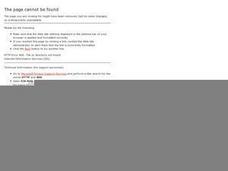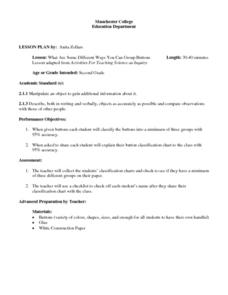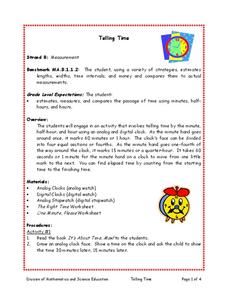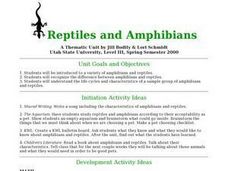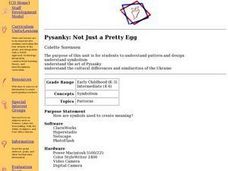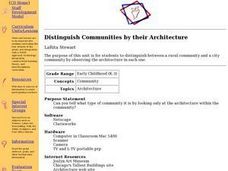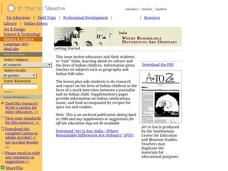Curated OER
Engineering: Which Roof Is Tops?
Learners determine regional climates by examining photos of house roofs. They observe teacher-constructed examples of roofs and make predictions as to which style is best for snowy climates. After evaluating the examples, they record...
Curated OER
Ants
Young scholars make sequential patterns by using ants and following the model. They identify different parts of an ant by matching the picture to the word name. Pupils identify the ant's life cycle by creating a chart using pictures.
Curated OER
Pumpkins By the Pound
Use pumpkins of various sizes to experiment with weight and perimeter. First the class lifts the pumpkins one by one, estimating each pumpkin's weight. They arrange the pumpkins from lightest to heaviest, and then string weigh each one...
Institute of Electrical and Electronics Engineers
Design and Build A Better Candy Bag
Young scholars discuss how the final design for a product can affect its success. They work together to design and develop a better candy bad. They predict the volume and strength they need for the bag to be successful.
Curated OER
Get Ready, Get Set, Hibernate
Students match each body part or idea from a work bank about methods of animal adaptations for winter survival. They observe as the first one, food is covered with the whole class before completing the rest of the diagram. They discuss...
Curated OER
Migration Nation
Students study the concept of animal migration. They explore the migratory patterns of four different animals. Specifically, they search for on-line information about the natural history of animals and explore reasons why animals might...
Curated OER
What Are Some Different Ways You Can Group Buttons
Second graders classify and group buttons. They discuss how their buttons are alike and different, and identify the characteristics of their handful of buttons. Students then classify their buttons into three groups, and create a...
Curated OER
Healthy Living: Multicultural Awareness and Appreciation Adaptation
Students recognize a globe and distinguish between land and water, as well as recognize different cultures. They become knowledgeable regarding geography and cultural diversity.
Curated OER
Telling Time
Students estimate, measure, and compare the passage of time using minutes, half hours, and hours. They read the book 'It's About Time, Max!' with the teacher and draw an analog clock face. They show the time and 30 minutes later, 15...
Curated OER
Ancient Peoples of the Middle East
This is an excellent multidisciplinary lesson designed by Scientific American. It provides three creative activities--designing a garden, studying hieroglyphics, and writing poetry--relevant to the ancient peoples of the Middle East....
Curated OER
The Anaconda
Learners examine basic facts about the anaconda. They discuss the length of an anaconda, estimate the length of 33 feet, compare their estimate to the actual length, and decorate the paper snake with colored scales.
Curated OER
Everybody Needs a Rock
Here is a lesson that rocks! Young scientists choose a rock and list words that describe it. They estimate the mass of their rocks and rank them within a group. They measure their rocks for volume and write a story that somehow includes...
Curated OER
Help the Duck Find Her Babies
Students study the basic need for animals to attract mates and reproduce young.
Curated OER
Learning from Letters and Other Mail
Students explore the history of our mail system. In this postal lesson plan, students evaluate mail as a means of communication, create a mail system in their classroom where they can send and receive mail. Once the students receive...
Curated OER
All About Trees
Second graders examine the artwork of Robert Harris and discuss how trees are an important part of their lives. In groups, they discover how people's use of the environment has changed over time and describe the climate and vegetation...
Curated OER
Pysanky: Not Just a Pretty Egg
Students examine the art of Pysanky. Using the Internet, they identify the cultural similarities and differences between the United States and the Ukraine. Using Pysanky's art, they discover the symbolism he used in his artwork and...
Curated OER
New Year Celebrations Around the Globe
Students view art images of Norman Rockwell's family traditions and celebrations. They search the internet for information, and complete reflective and creative writing and sketch assignments. Students recognize and name emotions shown...
Curated OER
Art to Zoo: Celebration
Students research and develop a report on birthday rituals around the world. In this research lesson plan, students compare birthday rituals from other cultures to their own. Images and resources are included.
Curated OER
Playing Historical Detective: Great Grandmother's Dress and Other Clues to the Life and Times of Annie Steel
Students draw conclusions about an mystery person based on documents and artifacts provided. In this drawing conclusions activity, students become detectives by reading and analyzing evidence provided. This activity includes...
Curated OER
Distinguish Communities by Their Architecture
Learners distinguish between a rural community and a city community by observing the architecture in each one. They observe and discuss pictures of buildings. Students write a paragraph explaining the purpose of a particular building....
Curated OER
Teaching With the Power of Objects
Students define value of an object. In this value lesson plan, students identify reasons for collecting objects, compile a personal inventory of items they find valuable, and then define why those items are valuable to them. In step two...
Curated OER
India: Where Remarkable Differences Are Ordinary
Students research India and Indian culture. In this Indian research lesson plan, students research and report on the lives of Indian children. The report will be in the form of a mock interview between a journalist and an Indian child....
Curated OER
Techno Timeline
Students create a timeline of inventors. In this dual history/science instructional activity, students research inventors of technological products, then work in groups to create a timeline of events. The timeline may include science...
Curated OER
KWL Chart
In this KWL chart worksheet, students fill out a graphic organizer about what they know, what they want to know, and what they learned about a given subject.





